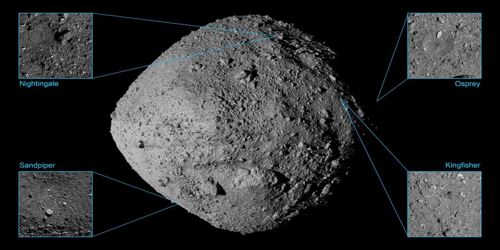NASA’s OSIRIS-REx spacecraft successfully touches asteroid to gather dust and pebbles
OSIRIS-REx spacecraft, which was launched in 2016, has successfully touched asteroid bennu. Asteroid Bennu, which is more than 200 million miles (321 million kilometers) from Earth, offers scientists a window into the early solar system. NASA’s first asteroid sampling aircraft – OSIRIS-REx has successfully touched asteroid Bennu to gather dust and pebbles from its surface to bring it to Earth for analysis. It will take one week to confirm if the spacecraft has collected enough samples for the study.
This well-preserved, ancient asteroid, known as Bennu, is currently more than 200 million miles (321 million kilometers) from Earth. Bennu offers scientists a window into the early solar system as it was first taking shape billions of years ago and flinging ingredients that could have helped seed life on Earth. This sample may give scientists clues about how planets, sun, and life came into being on Earth.
“NASA’s first asteroid sampling aircraft – OSIRIS-REx has successfully touched asteroid Bennu to gather dust and pebbles from its surface to bring it to Earth for analysis.”
The spacecraft performed all of its assigned tasks correctly but, it will take over a week for the team of scientists to confirm how much sample it has collected. “This amazing first for NASA demonstrates how an incredible team from across the country came together and persevered through incredible challenges to expand the boundaries of knowledge,” said NASA Administrator Jim Bridenstine. “Our industry, academic, and international partners have made it possible to hold a piece of the most ancient solar system in our hands.”
At 1:50 p.m. EDT, OSIRIS-REx fired its thrusters to nudge itself out of orbit around Bennu. It extended the shoulder, then elbow, then wrist of its 11-foot (3.35-meter) sampling arm, known as the Touch-And-Go Sample Acquisition Mechanism (TAGSAM), and transited across Bennu while descending about a half-mile (805 meters) toward the surface. After a four-hour descent, at an altitude of approximately 410 feet (125 meters), the spacecraft executed the “Checkpoint” burn, the first of two maneuvers to allow it to precisely target the sample collection site, known as “Nightingale.”
Ten minutes later, the spacecraft fired its thrusters for the second “Matchpoint” burn to slow its descent and match the asteroid’s rotation at the time of contact. It then continued a treacherous, 11-minute coast past a boulder the size of a two-story building, nicknamed “Mount Doom,” to touch down in a clear spot in a crater on Bennu’s northern hemisphere.
If OSIRIS-REx spacecraft has collected enough surface rock (at least 60gm), then the mission teams will command the spacecraft to begin its journey back to Earth in March 2021, when Bennu will be properly aligned with Earth for the most fuel-efficient return flight. Otherwise, they will have to try again in January 2021.
Real-time data indicates the TAGSAM successfully contacted the surface and fired a burst of nitrogen gas. The gas should have stirred up dust and pebbles on Bennu’s surface, some of which should have been captured in the TAGSAM sample collection head. OSIRIS-REx engineers also confirmed that shortly after the spacecraft made contact with the surface, it fired its thrusters and safely backed away from Bennu.

NASA thinks that the OSIRIS-REx spacecraft might find evidence of water on asteroid Bennu
“The team can’t wait to receive the imagery from the TAG event late tonight and see how the surface of Bennu responded to the TAG event.” The spacecraft carried out TAG autonomously, with pre-programmed instructions from engineers on Earth. It was a first for the United States — only Japan has scored.
OSIRIS-REx engineers and scientists will use several techniques to identify and measure the sample remotely. First, they’ll compare images of the Nightingale site before and after TAG to see how much surface material moved around in response to the burst of gas.
Next, the team will try to determine the amount of sample collected. One method involves taking pictures of the TAGSAM head with a camera known as SamCam, which is devoted to documenting the sample-collection process and determining whether dust and rocks made it into the collector’s head. One indirect indication will be the amount of dust found around the sample collector head. OSIRIS-REx engineers also will attempt to snap photos that could, given the right lighting conditions, show the inside of the head so engineers can look for evidence of a sample inside of it.
To store the sample, engineers will command the robotic arm to place the sample collector head into the Sample Return Capsule (SRC), located in the body of the spacecraft. The OSIRIS-REx mission set a goal of snagging at least 60 grams of asteroid material from Bennu. Based on images taken of the robotic arm and the collector, the team members are confident they’ve grabbed at least 400 grams of material — if not more. The pictures only show about 17 percent of what’s inside the sample collector, according to Dante Lauretta, the principal investigator of the OSIRIS-REx mission at the University of Arizona.
OSIRIS-REx spacecraft was launched from Cape Canaveral Air Force Station in Florida back in 2016, and after three years of its journey, it reached Bennu in 2018 and began orbiting the asteroid for the first time. Now it has safely collected samples from asteroid Bennu and is scheduled to return to Earth by 2023. OSIRIS-REx is the third mission in NASA’s New Frontiers Program, which is managed by NASA’s Marshall Space Flight Center in Huntsville, Alabama, for the agency’s Science Mission Directorate in Washington.














